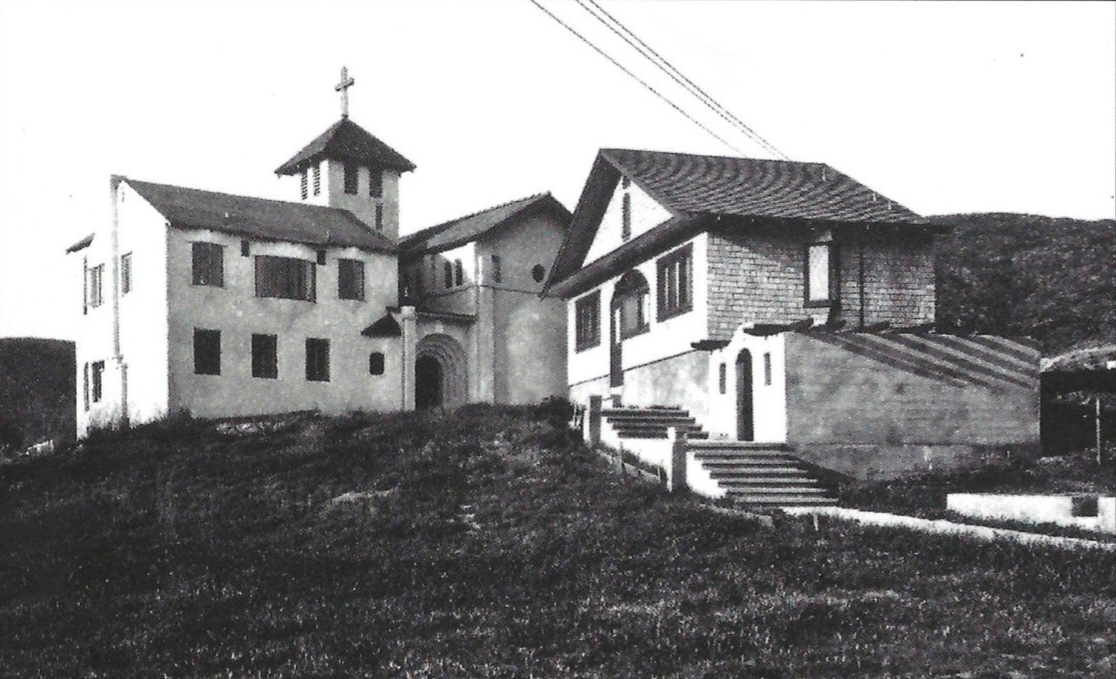By Hunter Fuentes and Jon Stordahl
Old St. Mary’s
One of us (the older one) attended Pine Junior High School in Los Alamitos in the mid-1970s. On January 28, 1986, the space shuttle Challenger exploded less than two minutes after launch, killing all seven crew members, including Christa McAuliffe, America’s “Teacher in Space.” It was a national tragedy. In response, the Los Alamitos Unified School District decided to rename Pine Junior High in McAuliffe’s memory. While undoubtedly appropriate, there is something disconcerting about simply erasing the former identity. What’s in a name?
We stumbled across an Aug. 9, 1972, article in the Laguna Beach Post, written by Jan Worth, titled, “What’s Worth Saving in Laguna Beach.” The column discussed the efforts of an ad hoc committee of city residents to identify landmarks in the town that were worth preserving. The compilation included three heritage trees, the gate hanging on the corner of Forest Avenue, and fourteen structures. One of those buildings deemed too important to lose was the old St. Mary’s Church. This structure has been sort of a “white whale” for us.
St. Francis by the Sea — Back view from Mermaid Street, 1930. Front view, 1936. Photos courtesy of St. Mary’s archives & Silver Images.
We had seen several mentions, as early as 1925, of an earlier building that had been the first home of the St. Mary’s congregation, as well as a few grainy photos of an imposing structure and tower. Details were hard to come by. One point was particularly intriguing; all the early references identified the building as “St. Francis By-the-Sea,” not “St. Mary’s.” The different names were a source of confusion. We spoke with Pat August, a long-time member of St. Mary’s vestry. She was able to provide answers and recommended the book “The Chapel on the Hill” by Starr Helms. Helms had already done the hard work.
She traced the roots of Laguna Beach’s Episcopal congregation back to the arrival of the charismatic minister, Rev. Percy Wise Clarkson. Clarkson was a fascinating man who wandered the world in search of a home and the truth. He was born in England in 1875, spent time in Canada and New Zealand before arriving in Orange County in 1922. His religious journey spanned the Church of England, the Free Church of England, Congregationalism, Primitive Methodism, Presbyterianism, and finally landed as an Episcopalian, at least for a while. He took over as resident priest at Trinity Church in Orange but quickly found his way to Laguna. In 1923, he established a summer ministry in our city to serve the visitor population. In 1925, he purchased six lots on Park Avenue and began to raise funds to erect a church building.
Reverend Percy Wise Clarkson
He built a structure that was somewhat smaller than it looked. Even with a footprint of only 18 feet by 64 feet, perched on top of the hill, it was visible all over town. An attached tower was crowned with a six-foot-tall gold-leaf cross that was illuminated at night. Having elements of both Romanesque and Italian design, the Rev. Clarkson christened the new church St. Francis By-the-Sea. The congregation flourished. Then the troubles began. Clarkson had a strong personality and an independent streak. He chafed at doctrinal rigidity and clashed with his ecclesiastical superiors. The breaking point was a divorce petition he filed against his wife, Margaret, in September 1927. The uproar that followed this announcement led to a break between Clarkson and the Episcopal Church. The next big surprise came when it turned out Clarkson, not the Episcopal Church, held the title to the Laguna property. He changed his religious affiliation to the “Liberal Catholic Church” and expelled his former congregants. The Episcopal faithful were without a permanent home for the next year or so.
Frontage of Park Avenue, St. Francis by the Sea during construction, 1925. Photo courtesy of First American Title Corporation.
In April 1929, the Episcopal Church was able to raise the funds needed to purchase most of the property from Rev. Clarkson. There were a few significant stipulations to the transaction. Clarkson retained ownership of lot 28, and he got to keep the name St. Francis By-the-Sea. He also retained control over the lich gate on Park Avenue that the congregation had used to access the church. He denied that access, forcing the Episcopal faithful to climb up the steep hill from Mermaid to reach their church. The original structure was rededicated as St. Mary’s Episcopal Church in May 1929. Five years later, Clarkson built the even more diminutive church that now stands next door to his former parish. He christened his new sanctuary with the familiar name, “St. Francis By-the-Sea American Catholic Cathedral.” Because of these perceived slights, many of his former parishioners called their new neighbor the “Spite Church.”
In 1958, the growing St. Mary’s Episcopal congregation built the “new” St. Mary’s, right on Park Avenue. The old church still stood behind the new. Over the years, the venerable old structure began to show its age. In that 1972 article, Jan Worth noted that the city council had voted to condemn the building. It was finally torn down in 1979. Few in town remember the “Chapel on the Hill.”
Rev. Percy Wise Clarkson shepherded his small flock until his death in 1942. He had an informal name change of his own, styling himself “Archbishop Constantine.” I guess there is something in a name after all.







